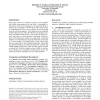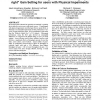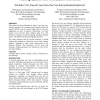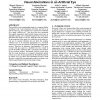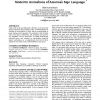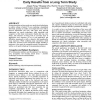ASSETS
2005
ACM
14 years 1 months ago
2005
ACM
This paper presents a method to convert vector graphics into tactile representations for the blind. Generating tactile pictures from vector graphics is an important effort to bri...
ASSETS
2005
ACM
14 years 1 months ago
2005
ACM
We designed and evaluated an agent that recommends a pointing device gain for a given user, with mixed success. 12 participants with physical impairments used the Input Device Age...
ASSETS
2005
ACM
14 years 1 months ago
2005
ACM
This study has been performed in order to test the manmachine interface of a computer-based speech training aid named ARTUR with the main feature that it can give suggestions on h...
ASSETS
2005
ACM
14 years 1 months ago
2005
ACM
ASSETS
2005
ACM
14 years 1 months ago
2005
ACM
The possibility of pre-compensating images in a computer display according to the visual aberrations previously assessed in an optical system (e.g., the computer user’s eye) has...
ASSETS
2005
ACM
14 years 1 months ago
2005
ACM
Anecdotal evidence suggests that Web document summaries provide the sighted reader with a basis for making decisions regarding the route to take within non-linear text; and additi...
ASSETS
2008
ACM
2008
ACM
Evaluation of a psycholinguistically motivated timing model for animations of american sign language
14 years 1 months ago
Using results in the psycholinguistics literature on the speed and timing of American Sign Language (ASL), we built algorithms to calculate the time-duration of signs and the loca...
ASSETS
2008
ACM
14 years 1 months ago
2008
ACM
We present a framework for technological aids for cognition intended primarily for individuals with cognitive impairments and seniors experiencing cognitive decline. We illustrate...
ASSETS
2008
ACM
14 years 1 months ago
2008
ACM
Many first-hand accounts from individuals diagnosed with autism spectrum disorders (ASD) highlight the challenges inherent in processing high-speed, complex, and unpredictable soc...
ASSETS
2008
ACM
14 years 1 months ago
2008
ACM
Existing knowledge on how people use speech-based technologies in realistic settings is limited. We are conducting a longitudinal field study, spanning six months, to investigate ...
